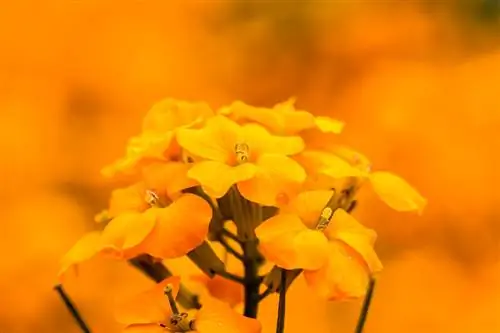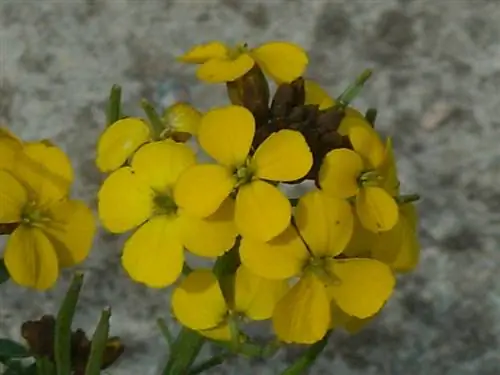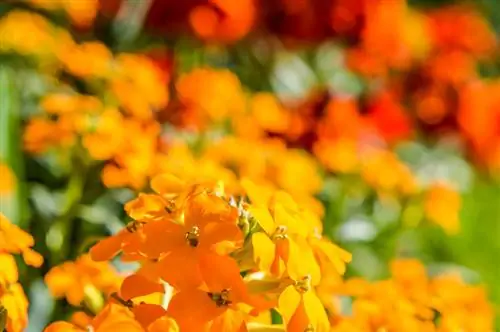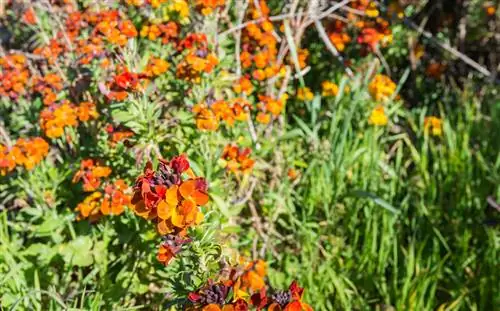- Author admin [email protected].
- Public 2023-12-25 17:45.
- Last modified 2025-01-23 11:20.
Where stone power meets golden yellow flowers, Goldlack achieves its floral masterpiece. The two-year-old to perennial Mediterranean Schöterich exudes its wonderful scent in the rock garden, on the tops of walls or transforms the balcony into a lush aromatic garden. The following answers to frequently asked questions explain what demands an Erysimum cheiri makes.
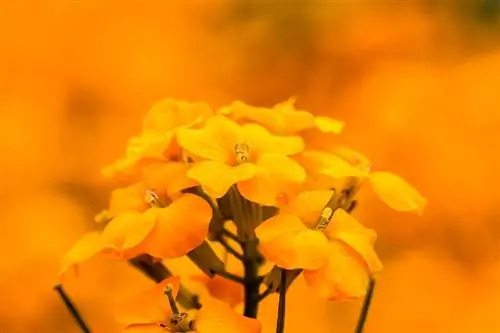
How do you care for gold lacquer in the garden?
Gold lacquer, also known as Erysimum cheiri, is a biennial Mediterranean plant ideal for rock gardens or balconies. Best sown from May to August, gold lacquer prefers sunny locations with moderately dry, sandy, humus-rich soil and requires moderate watering and fertilization in spring.
Planting gold lacquer correctly
The special advantage of a two-year-old plant is the uncomplicated planting using direct sowing. Save yourself the hassle of putting it on the windowsill and plant gold lacquer in the bed like this between May and July:
- Create a fine-crumb seedbed in a sunny location with moderately dry, sandy-humus soil
- Sift the dark germinators with soil at 3 times the seed strength, press lightly and moisten
- Keep constantly moist and separate seedlings with more than 2 pairs of leaves to 20-25 cm
- Plant out in August/September to the final location in the garden or in a pot and flower box
By the beginning of winter, every gold lacquer has developed a native rosette of leaves. In the bed, cover the plant with a layer of leaves and brushwood. Take seedlings planted in a pot to a frost-free, bright winter quarters. Next spring, the longed-for cluster of flowers will rise from the native tuft of leaves.read more
Care tips
Before you start any measure of the following care program, please wear gloves, because the toxic content of gold lacquer is serious:
- In case of prolonged drought, water moderately with normal tap water
- In March/April and after summer pruning, fertilize with compost (€12.00 on Amazon), horn shavings and lime
- Clean up wilted flowers for a never-ending blooming season
- Cut back remontant hybrids by a third in summer
In autumn, cut off the withered flower stems down to the basal rosette of leaves. This acts as a natural winter protection in the bed, supplemented by a thick layer of leaves and brushwood. Potted flowers move to a frost-free, light winter quarters.read more
Which location is suitable?
Surrounded by sun-drenched, warm and protected stone structures, a gold lacquer thrives lushly and he althily. A location surrounded by air is an advantage so that the dense flowers and leaves dry quickly after a downpour. In partially shaded, low-light places, however, the Mediterranean flower looks sadly away.
What soil does the plant need?
An Erysimum cheiri wants a lean, well-drained and sandy-loamy soil. As is typical for rock garden plants, the soil should be calcareous. To ensure that a schöterich thrives in normal garden soil, simply add a little sand, fine grit and garden lime. Please proceed similarly with the potting soil for pot cultivation.
When is flowering time?
In the second year, the gold lacquer blooms from May to August. If you cut off withered flower stems regularly, new plate flowers will appear and the well-groomed appearance will be preserved. Innovative hybrid varieties have the potential for rebloom. After the first flower bloom, these receive a repair cut so that they can show off their blooms again in September.read more
Cut gold lacquer correctly
Regular cleaning of wilted flowers ensures a long-lasting flowering period. If there are no more buds visible on the subshrub, cut off the gold lacquer down to the basal foliage. If self-sowing corresponds to your gardening design plans, wait until the wind spreader has been able to sow its seeds. Please only carry out cutting work with the protection of gloves so that you do not come into contact with the highly toxic ingredients.read more
Pouring gold lacquer
Your gold lacquer prefers slightly moist soil that neither dries out completely nor stands in water. Dried substrate always indicates a need for watering. Please avoid targeted bombardment with the garden hose. It is better if normal tap water slowly runs out of the can spout onto the root area until no more moisture is absorbed there.
Fertilize Gold Lacquer correctly
Starting fertilization in March/April in the form of compost, horn shavings or bark humus provides your gold lacquer with all the important nutrients for a lavish abundance of flowers. Remontant hybrids receive a follow-up in conjunction with summer pruning. If you spray the soil several times in autumn with comfrey manure, the potassium it contains makes a valuable contribution to strengthening winter hardiness. Potted flowers receive a liquid fertilizer for lime-loving plants every 2-3 weeks from April to August.
Wintering
These are the varieties with simple flowers that have sufficient frost resistance for overwintering in the bed. However, these plants will not survive the cold season he althy without your support. In the first year of growth and after pruning in the fall of the second year, cover the bed with leaves and coniferous twigs. The magnificent hybrids with double flowers are planted in pots and flower boxes right from the start. This makes it easy to move your beloved gold lacquer to a bright, frost-free winter quarters. Here you water the root ball every now and then so that it doesn't dry out.read more
Propagate gold lacquer
With its unmistakable pods up to 6 cm long, the gold lacquer offers propagation by sowing. If you don't want to let the schöterich spread, collect the ripe fruits in autumn. Please consider the extreme toxic content and take adequate safety measures for your he alth. Instead of sowing directly in May, you are welcome to use the quiet winter time to grow on the windowsill. Cover the dark germinators with substrate three to four times the seed strength. Germination progresses quickly in a partially shaded window seat at 18-20 degrees Celsius.read more
Gold lacquer in the pot
In pots and flower boxes, gold lacquer enchants us with colorful flowers and an intoxicating scent. In any case, we advocate this form of cultivation because the Mediterranean ornamental plant can easily relocate to its protective winter quarters. As a substrate, use pot plant soil that has been emaciated with sand and grit and fill it over a drainage system made of pottery shards. If you clean out wilted flowers every few days, the decorative effect will last throughout the summer. Before clearing away in autumn, cut the shoots down to the basal leaves. In a bright, frost-free room, water only slightly and do not give any fertilizer.
Is gold lacquer poisonous?
Gold lacquer is one of the highly poisonous ornamental plants. An Erysimum cheiri contains similar toxins to those in the dreaded red foxglove. The Mediterranean plant is therefore unsuitable for the family garden. The same applies to cultivation within reach of cats and dogs. Please wear gloves and long-sleeved clothing whenever you come into contact with the cruciferous vegetable.read more
Beautiful varieties
- Canaries: The golden yellow inflorescences attract everyone's attention in the bed and on the balcony; Growth height 30 cm
- Bowles Mauve: The two-year-old variety adorns the rock garden with purple-violet, wonderfully fragrant flowers; Growth height 60 cm
- Constant Cheer: Still tinted orange when it blooms, this gold lacquer transforms into a pink-purple flower dream; Growth height 30 cm
- Jubilee Gold: The premium variety impressively demonstrates why the flower is called Goldlack; Growth height 30 cm
- Fragant Star: Yellow-gold plate flowers with a diameter of 20-25 mm unfold from red buds; Growth height 40 cm

